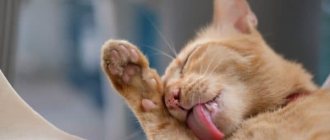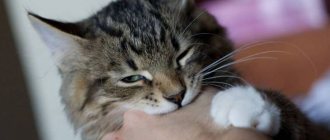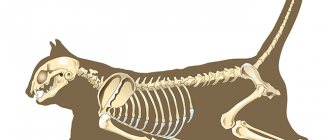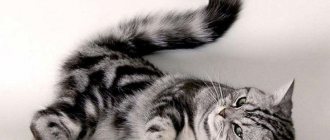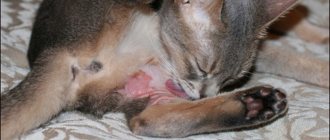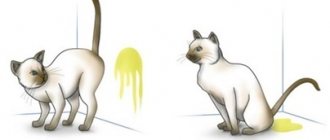Absolutely every cat, regardless of its age, breed and living conditions, tries, as far as possible, to keep itself in ideal (by their standards) cleanliness. It is for this reason that the mustachioed pet carefully licks its fur, body, each paw, tail several times a day with great diligence and, of course, does not ignore its own genitals.
However, excessive zeal in the form of constant licking of the genital area can often alert vigilant owners and make them think about going to a specialist at the nearest veterinary clinic.
What to do if your cat constantly licks under its tail?
If a cat licks under its tail no more than once a day, then this can be considered normal. Some pets pay increased attention to hygiene. But when this process becomes obsessive, licking may leave bald patches or even small wounds. In such cases, the possibility of worms should be excluded first. Then they consider the option with fleas. Only after antiparasitic treatments can other causes be considered if symptoms persist.
Possible options
Every cat licks under its tail at least several times a week. This process should not be considered pathological, provided that the animal is regularly treated against fleas and ticks (at least once a month) and undergoes quarterly deworming. If you add accompanying symptoms such as redness in the anus, discharge or the appearance of growths, it is recommended to exclude the following diseases:
- Inflammation of the paraanal glands. It can form after eating bones, due to excess weight, soft food. Prolonged diarrhea can also be a cause. The first signs of inflammation may include fidgeting on the butt, constant licking under the tail, and redness in the anus. The problem can be solved by cleaning (at least once every three months, if there is a predisposition to inflammation). It is performed by a veterinarian in a hospital setting. After cleaning, ointments (proctosedyl) and suppositories (ichthyol or sea buckthorn) are prescribed. A change of food and increased hygiene are also indicated.
- Fleas. They can cause itching in different parts of the body. But most often bites occur on the base of the tail and stomach. Therefore, if a cat licks under its tail, behaves restlessly, tries to chew out fur, or tears itself with its paw until it bleeds, then flea treatment should be carried out. The fact that your pet does not leave the house is not 100% protection against parasites. The owner himself can bring them on clothes or the soles of shoes. Fleas are not dangerous to humans (they do not parasitize the skin), but in some cases they can bite. All animals are treated, regardless of the presence of symptoms. The most effective drugs are Stronghold and Frontline. They are produced in the form of drops, which are evenly applied to the withers so that the animal cannot lick the drug. It is recommended to perform this procedure at least once a month.
- Worms. The most common reason why a cat may lick under its tail frequently. Just like with fleas, an animal does not have to go outside to pick up parasites. He may develop them after being bitten by mosquitoes, mosquitoes, or fleas. Also at risk are pets whose diet contains raw meat and fish. Well, we cannot exclude the possibility that parasite eggs may enter the apartment on the soles of the shoes of the owner or his guests. The first signs of worms are itching in the anus, due to which the cat can ride on its butt on the floor. Licking and gnawing of fur in this area also indicate discomfort caused by parasites. Diarrhea, vomiting and increased appetite (or, conversely, complete refusal to eat) can be considered concomitant symptoms of helminthic infestation. Veterinarians recommend starting to worm animals from 3-4 weeks of age. As preparations, you can use tablets, suspensions or drops on the withers. Of the tablets, Drontal and Milbemax are considered the most effective. They can even be given in crushed form, adding to food. Some manufacturers offer meat-flavored tablets, since many pets flatly refuse to undergo deworming.
- Injury. This option cannot be ruled out. A pet can injure the anal area while climbing trees or after playing or fighting with other animals. Even a small scratch can cause significant discomfort. Because of this, a cat can constantly lick under its tail until it becomes bald. In such cases, it is recommended to carry out antiseptic treatment of the affected area until complete healing. And limit the animal's access to the wound using a special medical cap.
- Neoplasm. Unfortunately, this option should also be considered, especially if the animal is over 10 years old, it has been treated for parasites and there are no visible injuries in the anal area. The tumor can irritate the intestines, which explains the pet's restless behavior. The cat constantly licks under its tail, refuses to eat, and suffers from constipation. If necessary, the doctor performs diagnostic laparoscopy, during which cells are taken from the formation for histological examination. Depending on the type (sarcoma, lymphoma) of the tumor, treatment is selected (chemotherapy, surgical excision). Unfortunately, with tumors in the intestine, the prognosis is always cautious, even if the operation is successful and there are no metastases.
Preventive actions
Fungal and bacterial infections can be prevented by practicing good hygiene. Special medications and treatments will help protect your cat from lichen, dermatitis, otitis media and other diseases. For prevention, you need to regularly treat your pet against fleas, ticks and fungi, and also wash the bowl and tray with disinfectants. Bathing with a special shampoo is beneficial for cats. This procedure only needs to be done once a year.
Important! After treating a kitten with anti-flea or anti-fungal products, the animal should not be bathed. It is forbidden to wet the area where the medicine was applied.
The cat licks itself to help itself
Sanitizing the tray and bowl
All items belonging to the cat - bowl, tray, toys, etc. - must be regularly washed and treated with disinfectants. This will protect your pet from infectious, fungal, viral and other diseases. The bowl can be washed with regular dishwashing detergent. Usually fungus does not form on a cat's bowl, most often in the tray. It is advisable to treat it with any antifungal spray against lichen. Additionally, you can treat the tray with camphor alcohol, which not only cleans and disinfects the surface, but also eliminates unpleasant odors.
The bowl and tray should be washed and disinfected regularly
Special flea products
There are many treatments available at pet stores for fleas and other external parasites. They are available in the form of drops on the withers, sprays and collars. It is advisable to treat the cat with drops on the withers; this is the most effective remedy. The room can be sprayed with flea spray. Flea collars are not very effective. It does not destroy insects, but only repels them. A collar can only be put on a cat if it has recently been treated for fleas. Flea drops such as Leopard, Frontline, Advantage, Inspector, and Bolfo spray are very effective.
Flea remedies
The cat constantly licks itself: the reasons for this behavior
Absolutely every cat, regardless of breed, age and living conditions, tries to keep itself clean. Therefore, every day the pet is carefully licked several times - its fur coat, body, each paw in turn, tail and genitals. But sometimes the completely natural process of grooming an animal takes on the character of an obsession, and the cat constantly licks, and the reasons for this behavior are not always clear. This needs to be sorted out.
Cats usually lick and groom themselves after sleeping or eating. And this is normal, since cats are very clean by nature. But it happens that a cat begins to lick a specific place longer and longer. And for each situation there are reasons.
How to express your love for a cat?
If you want to show
If your cat
loves
, then it is enough for him that you feed him from your hands, not forgetting to pet him as often as possible. And if the cat turns over on its back and allows you to stroke its tummy, this indicates the highest degree of trust. Cats are not the hardest working animals.
Interesting materials:
How to display the hourly rate? How to display a Zoom meeting on TV? How to get rid of a dry cough at home? How to remove a grease stain from a polyester jacket? How to remove a grease stain from a wool coat? How to output sound from TV to home theater speakers? How to output sound from a TV to a music center? How to squeeze more juice out of oranges? How to call a Ukrtelecom technician? How to call Mosgaz?
The cat licks and itches, but there are no fleas
Even if no fleas were visible during a visual inspection of the cat, this does not mean that there are none at all. Very often, small black grains are visible among the fur, very similar to trash - these are nits. And sometimes, small transparent bubbles – lice eggs – are attached to the pet’s hairs.
However, not only fleas can cause a cat to lick and itch. This can also be done by other pathological microorganisms, such as scabies mites. In this case, the pet will have visible skin damage on the ears, ankles and elbows.
Other possible reasons for your pet licking and scratching include:
- Allergies to food, plant pollen, hygiene products, or insect bites (the cat scratches its face, scratches its ears, intensively licks and bites its paws). In this case, the veterinarian will recommend a diet to test for any specific component of the food that is causing adverse effects.
- Fungal and bacterial inflammation. A set of certain fungi and bacteria are found on the skin and mucous membranes of both humans and their pets. Being in a normal state, these microorganisms do not harm. But if the immune system weakens, their number quickly increases, and inflammatory processes begin. Fungal inflammation causes severe itching.
- Otitis is an ear infection that causes itching. A cat with otitis media itches and displays the following signs: it scratches its face, furiously rubs its ears, and shakes its head; swelling and redness of the ears appears, and purulent discharge from the ears.
- Skin diseases (pyodermitis, notoedrosis, demodicosis, etc.) arise as a result of skin pathologies. The rashes that appear on the skin cause severe itching and discomfort. Scabies can also be accompanied by external signs such as baldness.
What to do if your cat is constantly licking
Having noticed that the cat has begun to lick and scratch almost all the time, and this is no longer simple self-care, the owner first of all needs to examine his pet for fleas. If fleas are not found, you need to remember whether one cat food was changed to another, whether a new shampoo was used, and whether any plant bloomed in the house.
A cat that scratches itself until it bleeds, licks itself and shakes its head frequently is most likely suffering from one of the skin diseases. You need to take her to the vet immediately. It will not be possible to make a diagnosis on your own, since scratching can be accompanied by many pathologies.
At the veterinary clinic, scrapings will be taken from the cat and microscopic and bacteriological studies will be carried out on their basis. They will allow you to identify fungal spores (if microsporia and trichophytosis occur) or mites (if demodicosis, sarcoptic mange or notoedrosis are present).
If the veterinarian suspects hormonal disorders, he may refer you for a blood test and, based on the results, will conduct an examination of the cat’s endocrine system.
Symptomatic diet and procedures
The best treatment is prevention. Therefore, to prevent the occurrence of this symptom, it is important:
- Regularly wash the cat's food and drink bowls, clean the cat's house, bedding and carpets indoors.
- Regularly inspect your cat's fur, comb it out and remove tangles.
- Clean your cat's ears and keep them clean.
- Supplement the daily diet with vitamins and microelements, especially if the cat has recently been ill and its body is weakened.
- Do not allow your pet to come into contact with dirty street animals.
- Give your pet enough attention and don’t forget to caress her.
You can help the animal solve psychological problems on your own. There is no need to lock your cat in a small room. If you are going to the country for the summer, take your pet’s house with you. After moving or adding another animal to your home, try to spend a little more time with your pet at first. If you help a cat realize its predator or hunter instinct by playing with it for at least 20 minutes, it will be easier for the animal to cope with stress.
Cats love platforms raised above floor level. They consider them a good place to retreat in case of danger. They can sit on these sites, experiencing moral discomfort. It’s good if you can equip a pet house on one of the sites. If necessary, the cat can retreat and survive stress in a secluded place.
Treatment
The veterinarian prescribes treatment not that concerns the itching, but that concerns the very cause of the disease. The course of treatment consists of taking medications and includes both local and internal medications. Depending on the cause of the disease, the veterinarian may prescribe antibiotics, antihistamines (to eliminate allergies), and antifungals.
If scabies and redness of the skin are caused by an allergy to food or hygiene products, their use will have to be stopped and the food replaced with another, in general, to get rid of all allergens.
Therapeutic measures
Any skin, parasitic or endocrine diseases should be treated immediately. The duration and method of treatment depends on the cause of the disease. If you have an allergy, you need to adjust your diet and remove the allergen. Ringworm is treated with antifungal ointments and tablets. For inflammatory and infectious diseases, a course of treatment with antibiotics and anti-inflammatory drugs is prescribed. Regardless of the cause of the disease, treatment always takes a long time: from 3 weeks to 2 months. It is necessary not only to help the cat stop itching, but also to completely eliminate the infection.
Treatment is prescribed depending on the cause of the disease
Preventing itching
Prevention of itching plays a very important role, so compliance with its basic measures will prevent the development of pathological processes accompanied by unpleasant symptoms.
Carry out hygiene procedures as often as possible - wet cleaning, washing cat bowls and washing their bedding.
Regularly clean your pet's ears and treat them with special medications.
Provide your pet with a balanced diet and try to prevent it from coming into contact with other animals.
Now everything has become clear why a cat can lick and itch. To solve the problem with a cat licking, you will have to be patient and time. And it doesn’t matter whether it’s a psychological or physiological reason. By providing your pet with enough attention and proper care, you can count on the fact that after some time his life will return to normal and his fur will be restored.
Licking due to stress
Frequent licking is not always associated with the physiological health of the animal. Perhaps some psychological aspect plays a role in such a situation. Cats like their lives to go on without much change, so any innovation can cause them anxiety. Redevelopment of the house, the appearance of new pets, change of regime and similar innovations cause emotional distress in cats.
Solving a licking problem requires a lot of patience and time, regardless of whether the cause is physiological or psychological. If you provide proper care and attention, then after some time the pet’s coat will be restored, and life will return to normal.
Did you like the article? Subscribe to the channel to stay up to date with the most interesting materials
Every cat lover has asked himself why cats lick themselves. This is a useful hygiene procedure for furry pets. The cat licks itself to remove dirt and loose hair from its fur. Licking is necessary for proper thermoregulation of the body and maintaining health. But there are situations when a cat constantly licks itself. This is often a sign of serious illness.
The cat constantly licks its tail - reasons and whether to worry
Absolutely every cat, regardless of its age, breed and living conditions, tries, as far as possible, to keep itself in ideal (by their standards) cleanliness. It is for this reason that the mustachioed pet carefully licks its fur, body, each paw, tail several times a day with great diligence and, of course, does not ignore its own genitals.
However, excessive zeal in the form of constant licking of the genital area can often alert vigilant owners and make them think about going to a specialist at the nearest veterinary clinic.
How to treat?
Constant licking of fur down to the epidermis is not normal and requires therapeutic measures. It is impossible to eliminate the problem without finding out its original source. To do this, contact a veterinarian who will conduct a diagnosis and select medications if necessary. Drug treatment is required for atopic dermatitis. To eliminate itching, the following medications are prescribed for cats:
When a pet licks its fur to the skin under the influence of stress factors, the cat needs to be provided with peace and surrounded with care. If pathological licking occurs against the background of an allergic reaction, then the influence of the irritant on the cat’s body is immediately excluded. If the violation does not go away, then additional antihistamines are prescribed. To combat the problem caused by small parasites, pet hair is treated. For this purpose, you can use antiparasitic drops, tablets or sprays.
Reasons for this behavior
In cats, constant licking of the genitals can be caused by inflammation of the prepurcial sac - the so-called skin fold of the foreskin that forms the space between the head of the penis and the skin. The folds of skin contain preputial lubricant that surrounds the cat's penis.
whitish-yellow smegma of the foreskin, may occasionally accumulate along the entire perimeter of the preputial opening. Such discharge is considered normal by veterinarians. If for some reason an inflammatory process begins in the area of the foreskin, then this fluid includes inclusions of blood, pus or urine.
The reasons why a cat licks its tail may be as follows:
- Disease of the foreskin, including the occurrence of neoplasms (cancer) in this area, mechanical damage, balanoposthitis (inflammation of the foreskin).
- Diseases of the urethra: trauma, the formation of stones and their subsequent passage, neoplasia.
- Bladder diseases: stones, infectious inflammations, neoplasms,
- Pathology of the prostate gland: prostatitis, cysts, hyperplasia, neoplasms, abscess.
- Coagulopathy (bleeding) and thrombocytopenia that occurs in parallel with it (a decrease in the level of platelets in the blood) - such an ailment can be a consequence of poisoning with rat poison.
- Urinary incontinence - occurs due to displacement of the ureter, or improper functioning of the sphincter, which is responsible for the amount of urine released.
- The cat simply performs part of his daily toilet routine by thoroughly licking his genitals after going to the toilet.
- An animal can lick a wound under its tail. Surely every person has heard the point of view that a cat always heals itself by licking sore spots.
- A cat may lick under its tail due to the fact that it suffers from constipation; the painful sensations create constant torment for it, from which the pet tries to get rid of it in all available ways.
- Itching in the anus can also cause excessive licking under the tail; in this case, the owner should pay attention to the cat’s feces, if it contains traces of helminthic infestations, this particular cause must be gotten rid of.
- A cat may start licking its tail as a result of being in a stressful situation: moving to a new place of residence, castration, remodeling a house, having new family members or pets - absolutely all innovations can cause a cat to panic and plunge it into a depressive state.
Is it dangerous?
Frequent licking of a pet's fur should alert the owner. The following symptoms indicate the development of overgrooming:
- the appearance of bald patches in different parts of the body;
- areas with sparse hairs that often break;
- deterioration of the coat condition;
- signs of allergies;
- scratches, ulcers and other wounds on the skin of a cat that take a long time to heal;
- lethargy, apathy and reluctance to eat.
If the problem is neglected, it threatens to affect more areas on the animal’s body.
If you do not carry out treatment in time and do not get rid of the problem in which the cat licks the fur down to the skin, then there is a high probability of multiple bald spots appearing, which will deteriorate the appearance of the pet. When overgrooming, there is a risk of infection in the wounds, as a result of which an acute inflammatory process progresses in the deep structures of the epidermis. When a cat not only injures the skin through frequent licking, but also chews it out in pieces, necrotic lesions appear. Overgrooming is a common cause of disrupted natural hair replacement process.
Diagnosis of the disease
If a cat constantly licks its tail, then it is worth talking about the presence of a disease that can only be determined by a veterinarian. The owner, turning to a veterinary clinic for help, will certainly be faced with the following procedures:
- Submission of general urine and blood tests, as well as biochemical blood tests,
- Submitting urine for bacterial culture (this action is necessary for specialists to exclude the presence of an infection in a pet located in the urinary tract area),
- Carrying out cytology and other bacterial studies,
- If bloody discharge appears, the animal will have to undergo coagulation; this procedure is also necessary to identify the cause related to blood clotting disorders,
- X-ray of the abdominal cavity (helps to identify the presence of an inflammatory process, for example, prostate disorders),
- Ultrasound of the abdominal cavity.
Diagnostic measures
To correctly determine the reason why a cat licks itself too often, the veterinarian performs a number of diagnostic procedures. To diagnose lichen, a Wood's lamp is used. After this, the doctor takes scrapings from the sore spot and damaged hairs from the cat. Then the skin sample taken is inoculated onto a nutrient medium. Additionally, blood is taken from the cat to test for infections. All procedures together will help you find out the cause of the disease and heal your pet from the disease.
A cat's fur is examined with a Wood's lamp to diagnose lichen.
